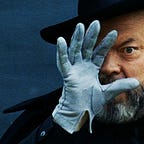Abbas Kiarostami’s Magical Doors
On the surface of it, Where Is The Friend’s House (1987) is a seemingly realist film that adheres to its realism throughout. However, as the film advances, Kiarostami ever so subtly and masterfully inserts small gestures of magical realism and fairy tale that profoundly affect the film’s narrative and elevate it to a dream-like level.
The film opens with a shot of a school room’s flapping door, later we will see that it has trouble staying closed as if possessed by a gently disruptive invisible force. Children in this film are condescended upon and bossed around by their adult supervisors. Ahmadpour, our child protagonist, is constantly ignored by the adults surrounding him, and one such adult is a metal door maker who surreptitiously goes around the surrounding villages convincing people to donate their old wooden doors in exchange for new and expensive metal ones (echoing Aladdin’s old lamp for new one exchange). When faced with a moral dilemma, Ahmad soon realizes that in order for him to do the right thing he must disobey his parents’ selfish orders and go on a journey to return his friend’s notebook.
Elements of Fairy Tale and Magical Realism
While steeped in realism, the journey Ahmad takes slowly begins to lace the film with a thread of magical realism tinged with a sense of fairytale that marks it beautifully. Night falls all too suddenly and soon enough the tight alley walls begin to light up with beautiful shapes and colors projected through the intricately designed windows and doors. Ahmad meets the old man who makes these doors who seems to be the only person to actually listen to him and help him with his plight. While the two walk through the alleys, the projections begin to take on an even more magical presence, growing bigger and more colorful as they go.
The sense of magical realism persists through Ahmad’s night even after his failed quest brings him back home empty-handed (full-handed in this case as he still has the notebook). With the wind raging outside his house, Ahmad sits down to do his homework, this time a violent force flings the room door wide open revealing a mundane but subtly chaotic scene that mesmerizes Ahmad: his mother gathering bedsheets in the wind.
Pre-existence of Cinema
Kiarostami seems to be suggesting that cinema has always pre-existed in one primeval form or another, even in small gestures, even within people themselves, and certainly within the relationship between humans and nature. The old door maker is a purveyor of dreams, a primeval projectionist of sorts, and an agent of beauty and force of good. On the other hand, the metal door maker is a dream thief, a trickster agent of metallic darkness and the death of art and beauty. Ultimately, the old door maker is the perpetrator of the film’s most beautiful gesture; a flower he asks Ahmad to place in his friend’s notebook during their journey, appears in the final shot back in the classroom, like a breathtaking exclamation of spontaneous art that overpowers the screen into freezing, and the film into ending.
These profound moments of magic that seem to puncture the prevailing realist sentiment of Kiarostami’s films will become a staple of his later works where the condensed tension of the film’s stark realism is broken by a moment of magic that is released into the air like a sigh of relief.
… In an upcoming post I will be discussing the two remaining films in Kiarostami’s Koker Trilogy, which began with Where Is The Friend’s House, and how Kiarostami was able to inject a self referential “meta” narrative, that goes several layers deep, despite the apparent realist tone of these three films.
